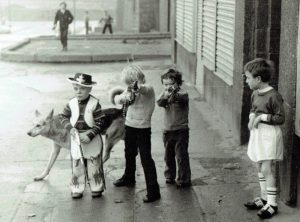
Glasgow is a city which has generated a massive literature of both fiction and non-fiction, including Irene Maver’s magisterial Glasgow, also published by Edinburgh University Press in 2000. Moira Burgess’s bibliography of the Glasgow novel has run to three editions. There are 76 pages of books about Glasgow on Amazon, and 1,692 titles about the city in Waterstone’s catalogue. There are 152 regular bloggers about the city, and dozens if not hundreds of occasional bloggers. By the same token, there are dozens if not hundreds of websites about the city’s various housing schemes on the Internet, with 51 photographs of individual housing schemes on “The Glasgow Story” website. Even a cursory glance at the Internet demonstrates that from the end of the First World War until the advent of multi-storey blocks in the 1950s, these housing schemes were of fundamental importance to their tenants. These websites show quite clearly that the tenants and former tenants valued them highly and have fond memories of the vibrant community life within them. The problem is that all too often, these memories can lapse into romantic nostalgia.
Given the importance of such housing in the history of Glasgow, constituting well over 60% in the post-war decades, what is striking is the lack of a comprehensive academic analysis of its development, on the one hand, and a history of the tenants’ housing experience, on the other. In my opinion, the academic treatment of Glasgow’s council housing is underwhelming, and is often limited to tables of statistics, and the uncritical reproduction of “commonsense” versions of the profiles of individual schemes. The detailed story of the lived experience of council tenants in their own voices is conspicuous by its absence. This seems to me to be a strategic lacuna in the social history of Glasgow, for not only did it involve thousands upon thousands of ordinary people, but also obtaining a new council house in the interwar and postwar years was one of the most important life experiences for working people in Glasgow. This became evident to me well over forty years ago when I did my research into the “Wine Alley” scheme in Govan. I was astonished to find in the course of my numerous interviews with tenants that they retained not only a detailed history of their scheme from the day it was first tenanted in 1935, but also a detailed recollection of the processes by which an offensive label became attached to it. The locals were able to theorise the social history of their scheme in colourful detail, and often their analyses were much more sophisticated that those offered by social scientists.
It was for these reasons, then, that I decided to try a more comprehensive social history of Glasgow council housing when I was Senior Research Fellow in the University of Glasgow’s Centre for Housing Research from 1988 to 1991. My colleagues knew a lot about housing associations and gated communities, but I doubt if many of them knew where Blackhill or Hamiltonhill or Teucharhill or The Bundy or West Drumoyne or Garthamlock were located.
I knew from my research in the early 1970s that Glasgow’s council housing was contained in a league-table of three separate and all-but hermetically-sealed categories: Ordinary, Intermediate, and Rehousing/Slum-Clearance. So I decided to research exemplars of the schemes in each of these categories for the interwar years, along with an experimental interwar scheme, and an anomalous post-war scheme which was supposed to break away from the rigid interwar categories, but in fact reproduced their economic and social characteristic faithfully.
The structural characteristic of the six schemes I studied were recreated from an analysis of both national and local housing policy, utilising a wide range of archival material in the Mitchell Library. Then the nature of community life and housing management tactics within these schemes was recreated by interviews with both contemporary Corporation of Glasgow officials, and pioneer tenants of each of these schemes. The importance of this story can be gauged by the fact that I was able to conduct literally dozens of such interviews, with both officials and tenants more than eager to tell me their stories. This book contains their stories, along with a critical analysis of the Corporation of Glasgow’s council housing policy. Thus it offers the comprehensive sociology of such housing which has been missing to date, and is important in that five of the six schemes I studied have already been demolished, and their story nearly lost.

Seán Damer is a sociologist who has published extensively both about Glasgow, and Crete. Following early retirement from his distinguished academic career, he turned his hand to creative writing. He has published one novel, just finished a second, and is working on several film and television projects.
- Scheming: A Social History of Glasgow Council Housing, 1919-1956 is available now. Find out more on the Edinburgh University Press website






